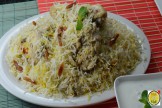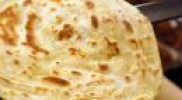Colorful and flavorful carrot and ginger soup is a light and easy soup. Carrot soup with ...

Bhatkali biryani is a special biryani savoured in all parts of coastal Karnataka. ...

This layered paratha is quite appetising to look at, and even more interesting to bite i...
Masala peanuts is a deep-fried snack very popular recipe in India. This makes a great mu...
Banana flower curry recipe tastes the best with sambar sadam. It is an excellent source o...

Carrot Radish Sorrel leaves Paratha is the best healthy and a power packed breakfast opti...
Thai veggie burgers topped with sweet . Thai pickles and a red curry cashew cream sauce.
Thai cuisine is the national delicacies of Thailand. Balance, detail, and wide range are of vital relevance to Thai chefs. Thai cooking demonstrated characteristic of a water-borne lifestyle. Marine animals, plants and herbs were key ingredients. Big pieces of meat were eschewed. Following affects presented the usage of significant pieces to Thai cooking.
Because of their Buddhist background, Thai's avoided the usage of... Read More..
|
About Recipe
|
|||||||||||||||||||||||||||||||||||||||||||||||||||||||||||
|
|||||||||||||||||||||||||||||||||||||||||||||||||||||||||||
Thai cuisine is the national delicacies of Thailand. Balance, detail, and wide range are of vital relevance to Thai chefs. Thai cooking demonstrated characteristic of a water-borne lifestyle. Marine animals, plants and herbs were key ingredients. Big pieces of meat were eschewed. Following affects presented the usage of significant pieces to Thai cooking.
Because of their Buddhist background, Thai's avoided the usage of big animals in large portions. Big cuts of meat were destroyed and laced with spices and herbs. Conventional Thai food preparation methods were simmering and baking, or grilling. Chinese impacts noticed the development of frying, stir frying and deep-frying. Cooking impacts from the 17th century onwards integrated Portuguese, Dutch, French and Japanese.
Thai cooking areas focus on gently prepared recipes with strong fragrant elements along with a hot and spicy edge. It is known due to its complicated interaction having a minimum of three and as much as four or five essential flavor senses in every dish or even the entire meal: sour, sweet, salty, bitter, and spicy.
Thai delicacies and also the cooking cultures and dishes of Thailand's neighbors have mutually affected each other during the period of centuries. Regional variants usually associate to neighboring states along with local climate and geography.
Many recipes which are now well-known in Thailand were actually Chinese recipes. This kind of recipes incorporate chok Thai (rice porridge), kuaitiao rat na (fried rice-noodles), salapao (steamed buns) and so on. The Chinese also introduced using a wok to cook, the method of deep-frying and stir frying dishes, several kinds of noodles, taochiao (fermented bean mixture), soya sauces, and tofu.
The perfect Thai meal is an enlightening mixture of the spicy, the delicate, the sweet and sour, and is supposed to be similarly gratifying to eye, nose and palate. An average meal may include a clear soup, a steamed dish, a curry dish with condiments, a fried dish, a hot salad and a number of gravies into which meals are dipped. This is accompanied by desserts or fresh fruits including mangoes, papaya, grapes or melon.
 Easy recipes
Easy recipes
 Healthy Recipes
Healthy Recipes
 Dessert Recipes
Dessert Recipes
 Mutton and Lamb
Mutton and Lamb  Indian Bread Recipes
Indian Bread Recipes
 Dal Recipes
Dal Recipes
 Chutney and Pickles
Chutney and Pickles  Indo-Chinese Recipes
Indo-Chinese Recipes
 Snacks and Appetizers
Snacks and Appetizers
 Low Fat Recipes
Low Fat Recipes
 Chaat Recipes
Chaat Recipes
 Biryani and Rice
Biryani and Rice  Curry Recipes
Curry Recipes
 Indian Sweet Recipes
Indian Sweet Recipes
 Egg Recipes
Egg Recipes
 Paneer Recipes
Paneer Recipes
 Chicken Recipes
Chicken Recipes
 Indian tiffins
Indian tiffins
 Egg less Recipes
Egg less Recipes
 Soups and Salads
Soups and Salads
 Indian Sea Food
Indian Sea Food
 Manchurian Recipes
Manchurian Recipes
 Indian Drinks Recipes
Indian Drinks Recipes
 Dinner Recipes
Dinner Recipes